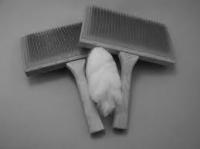Carding
 Carding is the process whereby raw wool is brushed and straightened until it is in a fit state for spinning. Carding machines began to be developed throughout the 18th century; before that, it was done by hand using a pair of ‘cards’ – squares of leather fixed to a wooden back shaped like a paddle with small hoops of wire embedded in the leather. The quality of the yarn produced was dependant on the quality of the cards that were used.
Carding is the process whereby raw wool is brushed and straightened until it is in a fit state for spinning. Carding machines began to be developed throughout the 18th century; before that, it was done by hand using a pair of ‘cards’ – squares of leather fixed to a wooden back shaped like a paddle with small hoops of wire embedded in the leather. The quality of the yarn produced was dependant on the quality of the cards that were used.
Making a card involved cutting wire into small lengths, sharpening these at both ends, bending them into hoops, then embedding them into holes punched in the leather. If done by hand, this was going to be very hit and miss; doing it by machine would ensure greater uniformity in the size of the hoops and their spacing on the leather, which would in turn ensure a better quality of wool that was prepared for spinning. This is why John Kay devoted his later life in France to developing a machine to make better quality cards; the result was two machines, one to cut and sharpen the wire, the other to punch the holes in the leather. Setting the wire was still done by hand, and the French complained that though the quality of the cards produced was better, they were too expensive.
John’s sons Robert and William developed on their father’s work in England. William, working in Tooley Street in London, still used two machines, though he set the holes in the leather diagonally and claimed a better quality of yarn from this. He was able to work 15lb of wire a day and achieved a six-fold increase in productivity. Robert, living in Bury, was primarily a shuttle-maker, but by 1794 had united his father’s machines into one and removed the need for setting by hand, thus mechanising the whole process. But until 1799, when a patent was taken out by Amos Whittemore in America, the use of cardmaking machines seems to have been the exclusive preserve of the Kays, both of whom were very secretive about their work, and neither of whom really capitalised on their financial potential. (Source: Julia Mann, Textile History 1976)